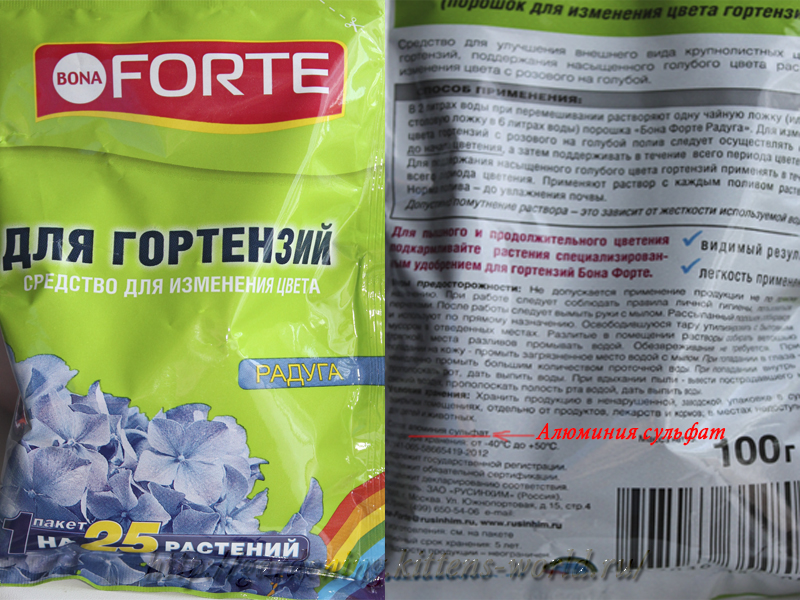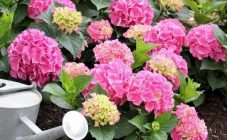Content:
Hydrangea is a flowering shrub whose charming flowers have bright, beautiful colors. It was brought to Russia from Asia. This plant belongs to the class of dicotyledons. Blooms from early spring to late autumn. Flowers are collected in inflorescences. These adorable white, cream, purple, blue or red balls are simply impossible to take your eyes off. Inflorescences can be in the shape of an umbrella or panicle. The fruit is a capsule containing small seeds. The plant is in the form of shrubs, less often in the form of a tree or liana. And her color is often white and pink, although the shade can really change. In the juice of large-leaved varieties, the pigment delphinidin 3-monoglycoside is present. When combined with many substances, complex chemical reactions occur, due to which the color of the inflorescences can change.
How to water a hydrangea so that it changes color
Slightly changing the color of garden hydrangeas is easy. But the effect will be temporary, and the changeable pigment will only be visible in the veins of the petals.
To paint brushes in pink tones, you need to water the bush with a weak solution of potassium permanganate.
If you water the plant with a solution of ferrous sulfate (1 teaspoon for half a bucket of water), then you can change the tone of the petals of this flower to a beautiful purple. The same effect can be easily obtained if metal shavings or nails are buried under the hydrangia bush.
With the help of alum, a blue tint of the petals is obtained.
What else to water hydrangea to change color
But there are other, more effective methods, using which you can change the color of hydrangia from pink to blue or purple. Only it should be borne in mind that not all varieties of this plant can change the color. White hydrangea, both tree-like and paniculate, does not react to the acidity of the soil, therefore, it will not change the color. Only one species can change the color of its petals. Large-leaved hydrangeas change the color. This is due to the content of special elements in the cells: anthocyanins, which are very sensitive to the pH level of the soil, and the amount of aluminum salts in it.
The color of large-leaved hydrangeas can be:
- pink;
- blue;
- crimson.
Also, representatives of this species can be two-colored and even three-colored.
The colors of these plants change from the presence of aluminum in the soil and its acidity, which is checked using litmus papers (from the school curriculum, everyone remembers phenolphthalein in raspberry acid), which are included in the set of a special device. Also, the kit should contain instructions with a color scale and indicators of pH values. Buying a set is not difficult at any flower shop.
This species often becomes pink, but growers want to have both blue and blue. And it is possible!
How to water a hydrangea to get blue flowers
For this charming flower to bloom blue, the pH of the soil must be equal to 4.5. To increase the acidity of the soil, you can use in different ways:
- introduction of high peat into the planting pit during planting;
- adding coniferous litter to the planting pit;
- add water-soluble aluminum sulfate or aluminum alum;
- mulching using high peat and coniferous litter;
- fertilizing with mineral fertilizers (for example, kemir-wagon).
In addition, many flower growers use folk remedies, add lemon juice or even electrolyte to the water when watering.
It is also possible to achieve the desired acidity of the soil by watering the hydrangea with citric acid (2 tablespoons per 1 bucket of water). Such watering begins in early spring and is carried out every 2 weeks until the end of flowering. It is allowed to add such a solution only after watering with clean water.
If you distribute fertilizers under the bush not evenly, you get a very interesting picture: on one plant, flowers can become both blue and pink tones.
Thus, a novice florist needs to remember: for the blue color of inflorescences, acidic earth and aluminum salts are required. Aluminum is more important for painting than the acidity of the soil. Phosphorus forms poorly soluble compounds with aluminum. Therefore, to obtain the desired shade, phosphorus fertilizers must be reduced or eliminated altogether.
How to water a hydrangea so that it changes color to pink
For the plant to bloom pink flowers, the soil pH level must be at least 6.5. In this case, the root system is unable to assimilate aluminum salts. Excess acid in the soil is removed with lime or dolomite flour. But it is worth observing the measure, since various diseases can form in a highly alkaline environment, primarily chlorosis.
When is the best time to change color
Many novice florists, having read on the Internet that hydrangea can change the color of their flowers, wonder when to start these experiments. All manipulations associated with transplanting, pruning trees and other plants must be done before the start of sap flow. And the case with a change in the color of this flower is also no exception. Therefore, it is best to influence the change in tones in early spring, and then, during the entire growing season, monitor the acidity of the soil and carry out irrigation with top dressing.
Tips from experienced florists
It is, of course, very beautiful to grow a hydrangea with flowers of different colors on the site, but it is better to do it in containers. First, it makes it easier to control the pH level, and the added components are not washed out. Secondly, the soil is not "spoiled" by the introduction of various additives, since chemical elements can accumulate in the soil. And if in the future edible plants are planted in this place, then it is not a fact that they will be permissible to be eaten.
Most importantly, if the gardener began to maintain the acidity of the soil artificially, then the manipulations must be carried out all summer. The change in acidity is a big stress for plants.
Thus, having planted a white hydrangea in the country, when its color gets bored, you can easily and simply change it to pink, blue or blue. But in everything you need to know when to stop so as not to harm the plant and the site as a whole!














